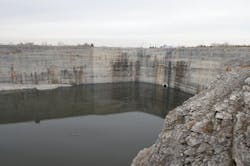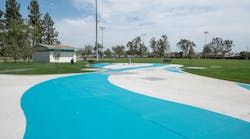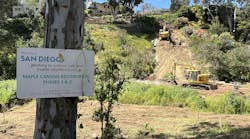APWA Bestows MWRD Thornton Composite Reservoir With Award
Engineers, contractors and miners preparing the Thornton Composite Reservoir might want to return to their designs and allow room for a trophy cabinet. Built to hold 7.9 billion gal of water, it is the world's largest combined sewer reservoir. It eliminates pollution from local waterways and saves the area from flooding. For the fourth time in a little more than a month, the creators of the reservoir have received an award.
The Metropolitan Water Reclamation District of Greater Chicago's (MWRD's) Thornton Composite Reservoir in South Holland and Thornton, Ill. has been named as one of the American Public Works Association's (APWA) Public Works Projects of the Year for 2016. This award follows reception of the APWA Chicago Metro Chapter's 2016 Project Excellence Award and the Award for Environment Projects of more than $75 million.
"This is another exciting honor, and it is a credit to our engineers, consultants and contractors who saw a barren land of limestone and through hard work and ingenuity turned it into the largest of its kind reservoir in the world," said MWRD President Mariyana Spyropoulos. "We now have the ability to save local communities in the South Side of Chicago and south suburbs from flooding and protect our vital waterways from pollution."
The MWRD is sharing this award with two co-primary contactors— the joint ventures of F.H. Paschen and Cabo Construction Corporation, and Walsh and II in One—and two co-primary consultants—Black and Veatch Corporation Inc. and MWH Americas Inc. The achievement will be recognized at the APWA annual Awards Recognition Ceremony held in conjunction with the 2016 PWX Convention in Minneapolis Aug. 29 at the Minneapolis Convention Center.
"Your selection puts you in a very elite group of winners and APWA is proud to have those on this project epitomize the public works profession and our association," wrote Rhonda Wilhite of the APWA in her letter notifying the MWRD of its award.
The $429 million reservoir is part of the MWRD's Tunnel and Reservoir Plan (TARP) connected to the MWRD's extensive network of deep tunnels. It benefits 556,000 people in 14 communities throughout the South Side of Chicago and south suburbs. It protects 182,000 structures, such as homes, businesses and other facilities, and improves water quality in the Calumet Rivers and Calumet-Sag Channel by collecting combined sewer overflows (CSO) before entering waterways. The reservoir's 7.9 billion gal capacity holds these overflows before pumping the water back via the 30-ft tunnel to the Calumet Water Reclamation Plant to be treated.
Major construction features of the project included: a double-row vertical grout curtain around the two-mile perimeter of the reservoir; a 112-ft tall roller-compacted concrete dam; a 1,300-ft long, 30-ft diameter connecting tunnel from the reservoir to the existing Calumet Deep Tunnel; and a 1,100-ft long, 20-ft diameter connecting tunnel from the reservoir to Thorn Creek.
The reservoir already made an impact in its first months of service by taking on its first water Nov. 26, 2015. By the time the rain stopped the following day, the reservoir was filled to a depth of 17 ft and held approximately 400 million gal of water. There were no CSOs in the reservoir's service area during the rain event, pointing directly to the effectiveness of the reservoir.
For their efforts in constructing the Thornton Composite Reservoir, the MWRD and miner Hanson Material Service (HMS) were also recognized for outstanding and innovative reclamation techniques at the annual Aggregate Miner Safety Conference and Illinois Association of Aggregate Producers (IAAP) Annual Convention in March in Springfield.
As large and unprecedented as Thornton is, however, it will no longer be recognized as the largest in the world come 2029. By then, the MWRD will have completed the McCook Reservoir in the southwest suburbs along the Stevenson Expressway between the Chicago Sanitary Ship Canal and Des Plaines River. When completed, the reservoir will hold 10 billion gal.
Source: Metropolitan Water Reclamation District of Greater Chicago


